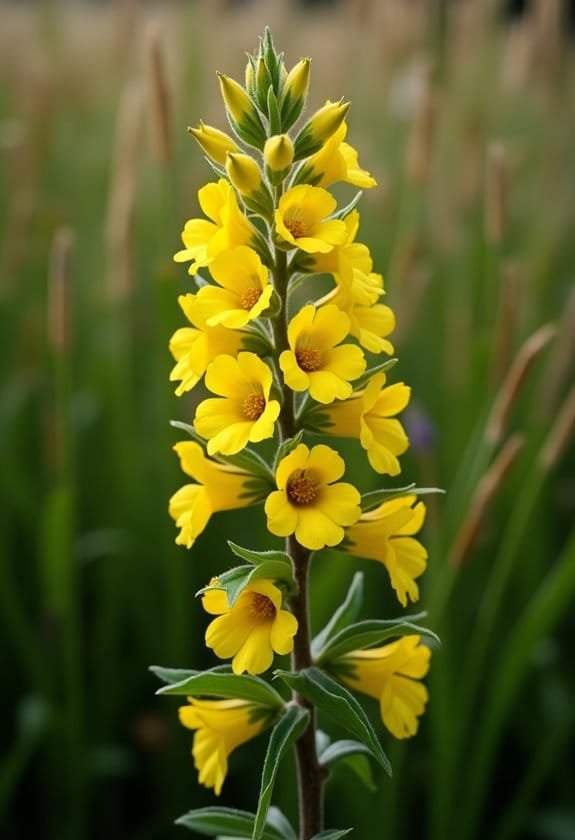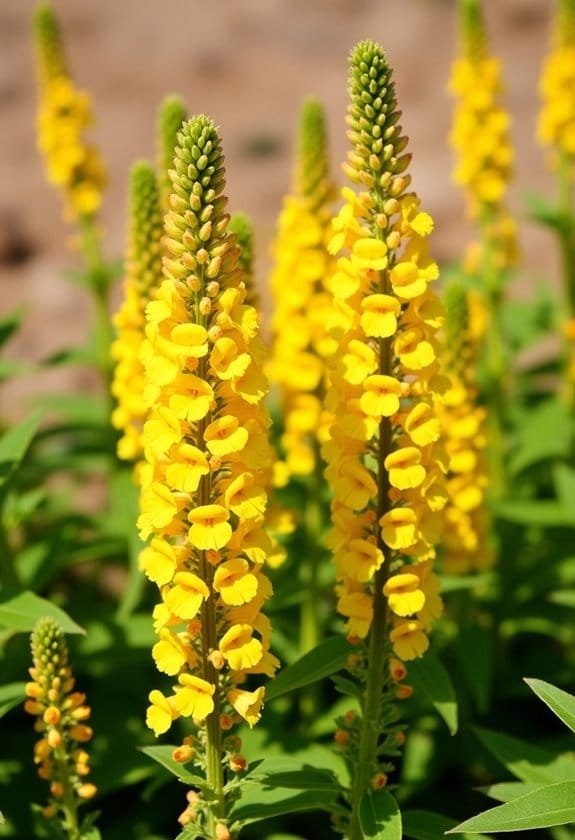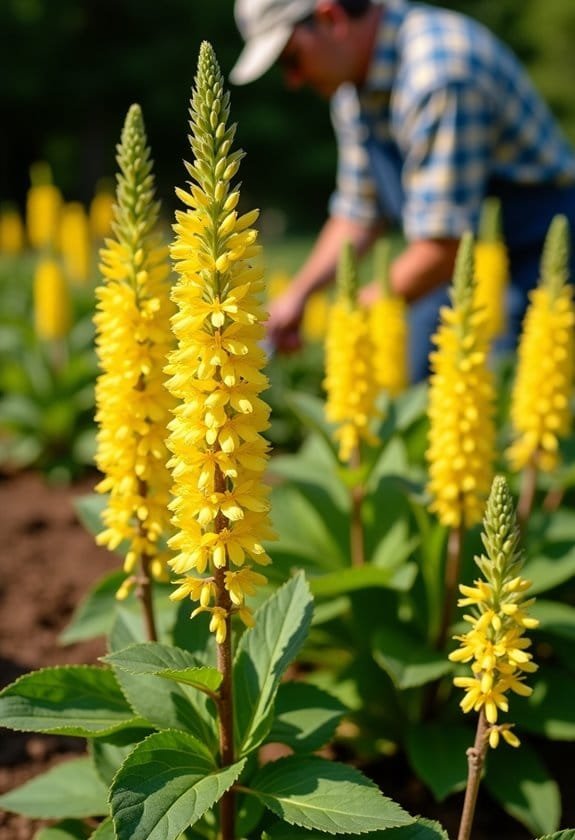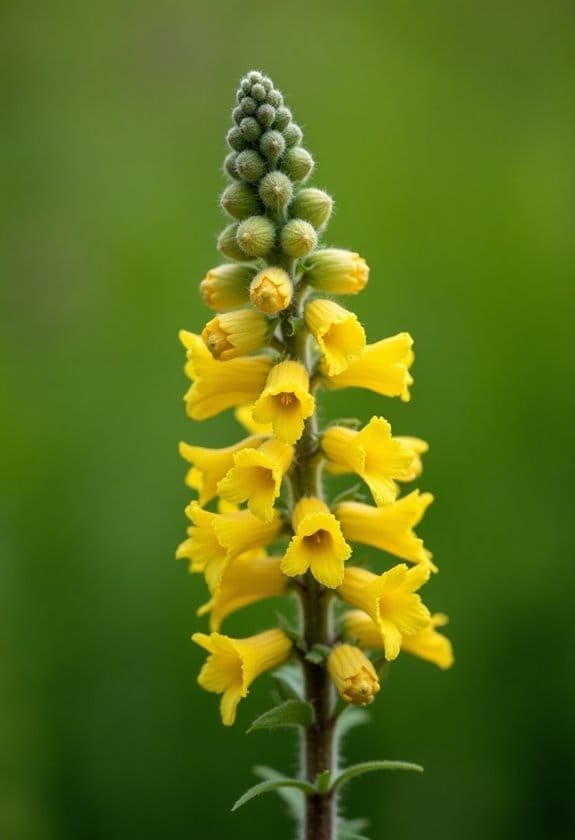Verbascum species, commonly recognized as mullein, encompass roughly 250 species, primarily thriving in Europe, northern Africa, and Asia. The well-known *Verbascum thapsus* reaches heights of 5 to 10 feet and features striking yellow flower spikes, which bloom from June to August. These plants prefer well-drained, slightly acidic to neutral soils, and they are drought-resistant due to extensive root systems. With a remarkable ability to produce 100,000 to 240,000 seeds per cycle, mullein showcases prolific reproduction capabilities. Essential for local ecosystems, mullein also poses invasive challenges, necessitating careful management to protect native biodiversity. More fascinating insights await those intrigued.
Main Points
- Verbascum species, including Common Mullein (*Verbascum thapsus*), thrive in full sunlight and well-drained soils, typically found in disturbed habitats.
- Common Mullein can grow 5 to 10 feet tall, featuring yellow flower spikes and fuzzy leaves in a rosette during its first year.
- It produces 100,000 to 240,000 seeds per flowering cycle, ensuring its survival and dominance in certain ecosystems.
- Mullein's flowering occurs from June to August, attracting pollinators like bees and butterflies, crucial for its reproduction.
- While beneficial for insects, Mullein can be invasive, requiring management strategies like manual removal or chemical treatments to protect native species.
Introduction

Verbascum species, commonly known as mullein, represent a diverse group of approximately 250 species that thrive primarily in Europe, northern Africa, and parts of Asia.
Among these, Verbascum thapsus stands out, reaching heights of 5 to 10 feet, with its striking yellow flower spikes and characteristic felt-like leaves forming large rosettes in its first year.
This adaptable genus not only showcases ecological resilience but also holds historical significance, as its introduction to North America in the 1700s prompted notable changes in local ecosystems.
Common Name
The common name "Common Mullein" reflects both the plant's fuzzy texture and its widespread presence in various habitats. Known for its striking appearance, Common Mullein is a biennial herbaceous species that initially forms a rosette of large, velvety leaves in its first year, subsequently reaching impressive heights of 6 to 10 feet.
In the second year, it showcases tall, upright stalks adorned with vibrant yellow flowers that bloom in summer, attracting a stunning array of pollinators, such as bees and butterflies.
This plant is often referred to as Woolly Mullein due to its soft, woolly foliage, which not only adds to its ornamental appeal but also serves as a habitat for beneficial insects.
While Common Mullein graces a variety of environments, from disturbed sites to meadows, it was historically introduced to North America in the mid-1700s primarily as a medicinal herb.
Curiously, some early settlers utilized it as a fish poison, demonstrating its diverse potential uses.
Today, it thrives in gardens and natural landscapes, contributing to both ecological balance and aesthetic beauty, firmly establishing itself as a beloved plant in many regions.
Scientific Name
Understanding the scientific classification of the common mullein reveals its rich botanical lineage and significance. The scientific name of this plant species is *Verbascum thapsus*, a designation first articulated by the renowned botanist Carl Linnaeus in 1753. The genus name "Verbascum" derives from the Latin term used historically for this plant, suggesting its long-standing presence in human culture and medicine. The specific epithet "thapsus" connects the species to an ancient Greek settlement, showcasing the intertwining of botanical nomenclature with historical geography.
As a member of the Scrophulariaceae family, commonly called the snapdragon family, *Verbascum thapsus* shares its lineage with various other flowering plants, enriching its classification.
Moreover, scientific assessments categorize this species within the sect. Bothrospermae subsect. Fasciculata, accentuating its particular taxonomic niche within the broader genus.
Botanic enthusiasts recognize three distinct subspecies of common mullein: *V. t. thapsus*, *V. t. crassifolium*, and *V. t. giganteum*. These variations differ mainly in flower size and hairiness, reflecting the incredible diversity and adaptability of the *Verbascum* genus.
Overview
Common mullein stands out as a striking biennial herb that's made its mark across various landscapes. Known scientifically as Verbascum thapsus, this plant is native to Europe, parts of Asia, and northern Africa, yet it gained prominence in North America after its introduction in the mid-1700s for medicinal applications.
In its first year, common mullein typically develops as a rosette of fuzzy, bluish-gray leaves, an intriguing precursor to its later grandeur. During the second year, it produces a tall flowering stalk that can soar between 5 to 10 feet, adorned with bright yellow, pentamerous flowers arranged in dense spikes from June to August. These flowers attract various pollinators, including bees, showcasing the plant's ecological significance.
A prolific seeder, a single common mullein can generate an astonishing 100,000 to 240,000 seeds, capable of remaining dormant for decades.
Although it doesn't aggressively invade habitats, its presence can become numerous in disturbed areas, where it often competes with native species for sunlight and nutrients. Consequently, while common mullein enchants with its beauty, it also poses challenges to the local flora.
Key Features
Common mullein (Verbascum thapsus) stands as a remarkable example of resilience and adaptability in the plant kingdom, reaching heights of 6 to 10 feet.
Its striking tall spikes burst forth from a rosette of fuzzy, bluish-gray leaves, adorned with vibrant yellow flowers that bloom from June to August.
This biennial plant not only captivates with its appearance but also impresses with its vigorous reproduction, producing up to 240,000 seeds that can lie dormant, waiting for the perfect conditions to germinate.
Growth Size
Mullein species, particularly the common mullein, can reach impressive heights ranging from 5 to 10 feet when fully mature. This biennial plant exhibits distinct growth habits: in its first year, the mullein develops a low-growing rosette of silvery-green leaves that can reach up to 50 cm in length.
These leaves are adorned with soft, star-shaped trichomes, giving them a uniquely fuzzy texture that distinguishes them from many other flowering plants.
During the second year of its life cycle, a remarkable transformation occurs as the flowering stalk emerges, showcasing striking bright yellow flowers arranged in dense spikes.
These flowers typically bloom from June to August, although each individual bloom lasts only a single day—a fleeting spectacle of nature. The impressive stalk height enables the plant to stand out in its environment, serving as a beacon for pollinators.
Moreover, the common mullein is notable for its prolific seed production, with each plant capable of producing between 100,000 to 240,000 seeds.
This remarkable capacity not only guarantees its survival but also facilitates its spread across diverse habitats. Ultimately, the growth size of mullein showcases its resilience and adaptability as a species.
Appearance
The tall flowering spike of Verbascum thapsus stands out in any landscape, reaching heights of 5 to 10 feet. This impressive growth is complemented by a solid flower stalk that can expand to about 2.5 cm in diameter.
At the base of this striking spike, the plant develops a large rosette of leaves during its first year, showcasing broad, silver-green foliage that can measure up to 50 cm long. The leaves aren't only visually appealing but also fuzzy to the touch, adding a unique texture to the plant's overall appearance.
As June arrives, the plant's one-foot long flower stalk becomes adorned with a profusion of yellow, pentamerous flowers, which bloom sequentially from the bottom to the top. Each flower, housing five stamens, optimizes pollination by maximizing its exposure during the daylight hours, opening at dawn and folding by mid-afternoon.
Following the flowering phase, Verbascum thapsus produces numerous seed capsules, each containing between 200 and 300 seeds. This prolific reproductive strategy guarantees the continuation of this stunning species, contributing considerably to its presence across diverse landscapes.
Flowering Season
Although Verbascum thapsus flourishes primarily during the warmer months, its flowering season takes center stage from June to August. During this flowering period, the plant showcases tall flower spikes adorned with bright yellow blooms. Each flower, measuring 1.5 to 3 cm wide, opens in the warm embrace of morning sunlight, attracting various pollinators before closing by mid-afternoon.
The flowering stalks, which can reach impressive heights of 5 to 10 feet, bear flowers in a spiral arrangement that ascends from the base to the top. This stunning display not only enhances the visual appeal of natural landscapes but also serves ecological functions, as pollinators depend on these nectar-rich blooms for sustenance.
It's essential to note that flowering typically commences for these biennial plants in their second year. After this vibrant show, the mature plant produces an astounding quantity of seeds—between 100,000 to 240,000—that are housed in seed capsules.
This prolific seed production enables extensive dispersal post-flowering, ensuring the continuation of the species and a legacy of beauty in the ecosystems they inhabit.
Growing Requirements

To successfully cultivate Verbascum species, particularly common mullein, one must consider specific growing conditions that satisfy its needs.
These plants thrive under full sunlight, prefer well-drained soils with a slightly acidic to neutral pH, and exhibit remarkable resilience in drought-prone areas, owing to their extensive root systems.
In addition, understanding their water requirements and temperature preferences can greatly enhance their growth, setting the stage for a vibrant display in gardens or natural landscapes.
Light
Sunlight is fundamental for the growth and flowering of common mullein (Verbascum thapsus). This remarkable plant thrives in full sun, demanding a minimum of 6 to 8 hours of direct sunlight daily to achieve ideal growth and impressive flowering.
Its intolerance of shade limits its competitiveness in densely vegetated areas, allowing it to flourish in open, disturbed habitats characterized by abundant light.
Interestingly, the germination of common mullein seeds hinges on this critical light exposure, as the seeds require light to initiate the sprouting process effectively.
Once established, the plant's preference for dry, well-drained sandy soils complements its need for sunlight, since such environments are often rich in light and poor in moisture.
Adequate exposure to light greatly influences not only the health of the plants but also the height of their towering flowering stalks, which can reach impressive heights of 5 to 10 feet.
These majestic stalks are essential for reproductive success, showcasing the intricate relationship between light, growth, and the flourishing of this stunning species in its preferred habitats.
Cultivating common mullein in ideal light conditions guarantees both its well-being and beauty in the garden.
Soil
When selecting soil for growing common mullein (Verbascum thapsus), it's important to take into account its specific preferences for drainage and pH. This hardy plant thrives in slightly acidic to neutral conditions, with a pH range of 6.0 to 8.0.
It flourishes best in well-drained soils that mimic its natural habitats—dry, sandy, or rocky environments. Mullein's deep tap roots enable it to tolerate drought, showcasing resilience in less-than-ideal situations.
While common mullein can adapt to poor soil conditions, it doesn't fare well in wet or waterlogged soils, making it particularly suitable for arid climates and urban landscapes where proper drainage is crucial. It often finds a home in disturbed soils, such as neglected pastures or construction sites, thriving where other plants may struggle.
In terms of sunlight, a location that receives full sun is ideal for fostering its vibrant growth and establishing strong blooms. Mullein can tolerate partial shade, but its best performance occurs in areas that bask in abundant sunlight, enhancing its overall health and robustness.
Planting in well-drained soils creates the foundation for successful mullein cultivation.
Water
During the growing season, common mullein thrives on careful water management that reflects its drought-resistant nature. This fascinating plant flourishes in well-drained soils, particularly favoring dry sandy or rocky environments. It truly excels in areas where moisture is limited, showcasing remarkable drought tolerance, which stems from its deep tap root. This extensive root structure enables common mullein to access water from deeper soil layers, ensuring its survival in less favorable conditions.
While the species can withstand periods of inadequate water, excess moisture poses a considerable risk, as it can't tolerate wet soils. Ideal growth occurs when the plant receives full sun exposure; however, it can adapt to some shade.
The soil's pH, ideally maintained between 6.0 and 8.0, also plays a crucial role in supporting robust growth. It's noteworthy that rich soils often require staking for the plant's tall stalks. Consequently, maintaining a balance in water availability and selecting appropriate soil types can greatly enhance the health and appearance of common mullein, fostering its thriving presence in drought-prone landscapes.
Temperature
Temperature plays an essential role in the growth of common mullein (Verbascum thapsus), as this biennial plant thrives best within a specific temperature range.
Ideally, it germinates at temperatures between 10-40°C, with light exposure being vital for seed germination. The favorable conditions during the growing season, which lasts at least 140 days, greatly influence its development.
Common mullein prefers well-drained, dry sandy or rocky soils, where it can access nutrients efficiently. Mature plants not only reach impressive heights of 5 to 10 feet but also display remarkable resilience in less-than-ideal environments. They tolerate annual precipitation levels of 50-150 cm, underscoring their adaptability.
However, they do require full sun for best growth, as they're intolerant of shade. This sunlight, combined with the right temperatures, fosters robust growth.
Moreover, the deep taproot of the common mullein allows it to be drought-tolerant, accessing moisture from deeper soil layers during dry spells. This capability not only supports its development but also enhances its survival in the face of changing climate conditions, showcasing the interplay between temperature, water availability, and overall plant health.
Pollinator Criteria
The common mullein (Verbascum thapsus) attracts a variety of daytime pollinators, thanks to its vibrant, bright yellow flowers that bloom in dense spikes.
These blossoms, opening at dawn and closing by mid-afternoon, primarily utilize specific bee species for pollination, enhancing the plant's reproductive success and seed production.
With each plant capable of producing up to 240,000 seeds, the presence of effective pollinators plays a critical role in sustaining mullein populations across their habitats.
Attracted Pollinators
Many pollinators find the common mullein (Verbascum thapsus) particularly appealing due to its bright yellow flowers that bloom consistently from June to August. The plant boasts towering flowering stalks, which can reach heights of 5 to 10 feet, adorned with densely arranged flowers.
This structure provides ample landing platforms for pollinators, particularly bees and butterflies, allowing easy access to nectar and pollen during the flowers' peak blooming hours, roughly from dawn to mid-afternoon.
Pollination primarily involves specific bee species drawn to the fragrant offerings of the common mullein. These pollinators increase reproductive success for the plant, ensuring the continuation of its life cycle.
However, it's important to highlight that the invasive nature of common mullein poses challenges to local ecosystems. By outcompeting native flora, it can diminish food sources for other pollinators, disrupting established relationships within the ecosystem.
While the common mullein serves as an essential resource for some pollinators, balancing its presence against the preservation of native species remains critical for maintaining biodiversity. Additionally, the pollination process itself is essential for enhancing genetic diversity within plant populations.
Ultimately, understanding these dynamics helps inform conservation efforts and promotes healthier ecosystems.
Pollination Method
Insect pollination is the primary method for common mullein (Verbascum thapsus), with its large, fragrant yellow flowers particularly appealing to specific bee species. These flowers bloom from June to August, attracting a diverse array of pollinators drawn by the ample nectar and pollen. Each flower opens for just one day, creating a critical window for effective insect visits and subsequent pollination before they close by mid-afternoon. Additionally, the flowering period of common mullein aligns with peak pollinator activity, providing a consistent food source for these important creatures.
Mullein exhibits a unique reproductive strategy called protogyny, where the female parts mature prior to the male parts. This adaptation enhances the likelihood of cross-pollination, although self-pollination can occur if pollinators are scarce. Mullein flowers are densely arranged in spikes, which facilitates pollinator access while promoting efficient pollen transfer.
The bountiful resources provided by common mullein greatly enhance local biodiversity, attracting not only bees but also other beneficial insects. The successful transfer of pollen leads to seed production, further contributing to ecosystem health. Additionally, the plant's ability to thrive in well-drained sandy soils ensures its continued presence in various habitats.
Consequently, the interplay between common mullein and its pollinators highlights the intricate relationships within nature, underscoring the importance of insect pollination in sustaining plant populations and promoting ecological balance.
Care & Maintenance

Caring for Verbascum species requires attention to their specific environmental needs and ongoing maintenance.
Thriving in well-drained soils with a slightly acidic to neutral pH of 6.0-8.0, these plants flourish best with full sun exposure, while also exhibiting remarkable drought tolerance due to their deep-root systems.
Regular monitoring for pests like spider mites, coupled with strategic companion planting, can't only enhance their growth but also promote a balanced garden ecosystem.
Planting Tips
When planting Verbascum species, especially common mullein (Verbascum thapsus), choosing the right location is vital for their success.
These plants thrive in well-drained, dry sandy or rocky soils, ideally with a slightly acidic to neutral pH ranging from 6.0 to 8.0. Full sun exposure is a must for ideal growth, enabling their impressive height of up to 10 feet.
When selecting a site, gardeners should consider areas with soil disturbance, such as roadside edges, clearings, or meadows—habitats where common mullein naturally flourishes.
Providing adequate spacing between plants allows for their expansive rosettes of leaves to showcase their striking visual impact.
Regular monitoring of soil moisture is essential; common mullein is intolerant of wet soils due to its deep tap roots, establishing it as a drought-resistant choice for xeriscaping.
Although relatively low-maintenance, pest management should be part of the plan, given their susceptibility to spider mites in hot weather.
Occasional inspections can prevent infestations, ensuring these magnificent plants thrive in your garden while adding beauty and resilience to the landscape.
Ongoing Care
Ongoing care for Verbascum species, particularly common mullein, requires diligence to guarantee these striking plants continue to flourish in the garden. Since common mullein thrives in well-drained, dry sandy or rocky soils and full sun, gardeners need to be vigilant about its environment.
Regular monitoring is essential, as established mullein populations can swiftly reappear following soil disturbance, competing aggressively against native flora and potentially dominating the landscape.
One of the most effective control methods is manual removal, ideally executed before flowering. This timing prevents the plant from setting an astonishing number of seeds—ranging from 100,000 to 240,000 per individual—thus disrupting the seed bank lurking within the soil.
When considering chemical control, herbicides like glyphosate or triclopyr should be employed cautiously to avoid collateral damage to desirable nearby plants.
After removal or application of control methods, minimizing soil disturbance is vital. By reducing agitation of the soil, gardeners can effectively limit the likelihood of seed re-emergence from the long-lived seed bank.
With diligent care, common mullein can coexist harmoniously in the garden, showcasing its majestic beauty while maintaining ecological balance.
Suggested Companions
Cultivating common mullein alongside compatible plants enhances not only its beauty but also the overall health of the garden. Mullein, with its tall, majestic spikes, pairs wonderfully with drought-tolerant plants like sedums and lavender, both of which prefer well-drained, dry sandy soils. Additionally, Vipers Bugloss provides essential nectar source for pollinators, making it a beneficial companion in sunny locations.
By situating these plants together, gardeners create a visually pleasing arrangement that thrives in sunny spots, crucial for mullein's ideal growth.
Integrating flowering perennials such as coneflowers or black-eyed Susans not only elevates aesthetic appeal but also encourages beneficial pollinators to visit the garden. These companions bloom at varying heights, allowing for a rich tapestry of color and texture.
Nevertheless, it's important to monitor plant interactions closely to combat mullein's potential invasive tendencies; it can easily outcompete native species if left unchecked.
Selecting shorter flowering herbs or ground covers that flourish in similar soil conditions will complement the towering structure of mullein effectively. Additionally, incorporating Vipers Bugloss into the mix can attract a diverse range of pollinators while thriving in well-drained soils alongside mullein.
Common Issues
Common mullein faces various pests and diseases that can hinder its growth and affect surrounding flora.
While the plant's thick leaves may deter some insects, it can become susceptible to fungal infections, like powdery mildew, particularly in damp conditions.
Implementing integrated pest management solutions, such as natural predators and appropriate fungicides, can effectively mitigate these issues, ensuring healthier growth of both common mullein and its environment.
Pests/Diseases
Pests and diseases can pose significant challenges for growers of Verbascum species, particularly the common mullein. This hardy plant, while generally resilient, isn't immune to various threats that can impede its growth and vigor. One of the primary concerns is the infestation of spider mites, especially during hot weather, which can lead to leaf damage and a noticeable decline in plant health.
Slugs and snails also represent occasional threats, as these pests can harm foliage, creating barriers to ideal growth. Additionally, Verbascum's preference for arid conditions exacerbates its vulnerability; excessive moisture can lead to stress and disease, particularly in wet conditions.
The dense growth habit of common mullein can further complicate matters, as it may suppress native species, contributing to biodiversity loss and earning its reputation as a noxious weed in certain regions.
This competitive nature adds to the challenges faced by gardeners, who must remain vigilant against these issues to guarantee robust and healthy plants. Understanding and addressing these common pests and diseases is essential for maintaining the integrity of mullein gardens and promoting healthy ecosystems.
Solutions
Addressing the challenges posed by pests and diseases is essential for gardeners working with Verbascum species, particularly with common mullein's invasive tendencies.
Common mullein (Verbascum thapsus) can rapidly dominate gardens since a single plant may produce between 100,000 and 240,000 seeds, outcompeting native species for precious resources. To combat this invasive threat, effective management strategies are vital.
One of the most effective methods involves manual removal before the plant flowers, allowing gardeners to tackle smaller infestations without resorting to chemical means.
For larger populations, herbicides such as glyphosate or triclopyr can be employed, although caution is necessary to avoid damaging desirable nearby flora. Careful application is key, as these substances can have long-lasting effects.
Moreover, the resilience of common mullein, with seeds that can remain viable in the soil for decades, necessitates regular monitoring post-management. This proactive approach helps prevent re-establishment.
Community engagement through awareness initiatives, focusing on proper identification and reporting of this invasive plant, further amplifies control efforts.
Together, these integrated strategies form a robust framework for managing common mullein and protecting the biodiversity of our gardens.
Summary

Verbascum species, particularly the common mullein (Verbascum thapsus), are notable for their tall, stately presence and distinctive fuzzy, silver-green leaves. Native to Europe and Asia, this biennial herb has now been widely introduced to North America, where it often thrives in disturbed areas. Common Skullcap (Scutellaria galericulata) shares similar wetland adaptations, showcasing the diversity of ecological niches among flowering plants.
Reaching heights of 5 to 10 feet, mullein can produce an astonishing 100,000 to 240,000 seeds over its lifetime. These seeds remain viable in the soil for decades, complicating efforts for biological control in natural habitats.
Mullein prefers dry, sandy soils with a slightly acidic to neutral pH and flourishes in well-lit environments. During the flowering period from June to August, it showcases bright yellow blossoms that attract a range of pollinators, such as bees and butterflies. Additionally, like the Lesser Spearwort's toxicity(#), mullein can also pose issues for local flora through its invasive growth patterns.
Effective management strategies for controlling mullein populations include manual removal before flowering and chemical controls, although integrated methods prove most successful in limiting its spread.
Considering its invasive nature, understanding its biology and habitat preferences is essential for effective management, ensuring that this striking yet problematic plant doesn't overwhelm native flora and disrupt ecosystems(#).


